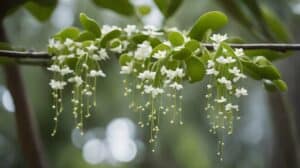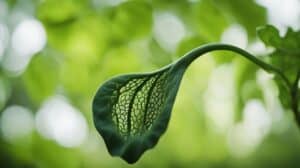Clivia Miniata is a beautiful and easy-to-grow plant that can brighten up any shaded garden.
Native to South Africa, this plant is known for its stunning orange or yellow blooms that appear in late winter or early spring.
With a little bit of care and attention, Clivia Miniata can thrive in a variety of growing conditions, making it an ideal choice for beginner gardeners.

One of the reasons why Clivia Miniata is so popular is that it is relatively low-maintenance.
Unlike many other plants, it can tolerate low light levels, making it a great option for gardens with limited sunlight.
Additionally, it is a hardy plant that can withstand a range of temperatures, from hot summers to cool winters.
With a little bit of water and the occasional dose of fertilizer, Clivia Miniata can thrive for years to come.
Whether you are looking to add some color to a shady corner of your garden or simply want to try your hand at growing a new plant, Clivia Miniata is a great choice.
With its stunning blooms, easy care requirements, and adaptability to a range of growing conditions, it is a plant that is sure to bring joy and beauty to any garden.
Understanding Clivia Miniata

Origins and Characteristics
Clivia Miniata is a popular flowering plant native to South Africa.
It belongs to the family Amaryllidaceae and is known for its beautiful blooms and ability to thrive in shaded areas.
The plant was first discovered in the early 19th century by a British botanist named John Lindley.
Clivia Miniata is a perennial plant that can grow up to two feet in height. It has dark green leaves that are long and strap-like.
The plant produces clusters of trumpet-shaped flowers that range in color from bright orange to yellow.
The flowers bloom in the spring and can last for several weeks.
One of the unique characteristics of Clivia Miniata is its ability to thrive in shaded areas.
It is an ideal plant for those who want to add color to their garden but have limited sunlight. Clivia Miniata can also be grown indoors as a houseplant.
Varieties and Colors
Clivia Miniata comes in a variety of colors and sizes.
The most common colors are orange and yellow, but there are also varieties that produce red and pink flowers.
The flowers can be single or double blooms and can range in size from small to large.
Some of the popular varieties of Clivia Miniata include:
- Clivia Miniata ‘Belgian Hybrid’ – This variety produces large clusters of bright orange flowers.
- Clivia Miniata ‘Golden Dragon’ – This variety has yellow flowers and is known for its large blooms.
- Clivia Miniata ‘Harlequin’ – This variety produces flowers that are a mix of orange and yellow.
In conclusion, Clivia Miniata is a beautiful and versatile plant that is perfect for beginners.
With its ability to thrive in shaded areas and its variety of colors, it is sure to brighten up any garden.
Cultivation Essentials
Lighting Requirements
Clivia Miniata is a shade-loving plant that thrives in bright, indirect light.
Direct sunlight can scorch its leaves, so it’s best to place it in an area that receives bright, filtered light.
North-facing windows or shaded outdoor areas are ideal for this plant.
Soil and Fertilization
Clivia Miniata prefers well-draining soil that is rich in organic matter. A soil mix that contains perlite or sand can help improve drainage.
Fertilize the plant once a month during the growing season with a balanced fertilizer. Avoid over-fertilizing as it can lead to root burn and damage.
Watering and Humidity
Clivia Miniata prefers to be kept consistently moist but not waterlogged. Water the plant when the top inch of soil feels dry to the touch.
During the winter months, reduce watering to allow the plant to go through a dormant period.
This plant also benefits from occasional misting to increase humidity levels around it.
In summary, Clivia Miniata is a low-maintenance plant that can add a pop of color to shaded gardens.
By providing it with the right lighting, soil, and water conditions, this plant can thrive and brighten up any space.
Planting and Care

Propagation Methods
Clivia Miniata can be propagated through division or seeds. Division is the easiest and most common method.
It is best done in spring when the plant is actively growing. Simply divide the clumps into smaller sections, each with a few leaves and roots.
Plant them in a well-draining soil mix and water thoroughly. Keep the soil moist but not waterlogged until new growth appears.
Seeds can also be used to propagate Clivia Miniata. Collect the seeds from mature pods and sow them in a well-draining soil mix.
Keep the soil moist and warm, and the seeds should germinate in about 4-6 weeks.
It may take several years for the plants to reach maturity and produce flowers.
Pruning and Maintenance
Clivia Miniata requires minimal pruning. Remove any dead or yellowing leaves as they appear.
Cut back old flower stalks to the base after they have finished blooming. This will encourage the plant to produce new growth and flower stalks.
Clivia Miniata prefers to be slightly root-bound, so repotting is only necessary every 2-3 years.
When repotting, use a well-draining soil mix and a pot that is only slightly larger than the current one.
Pest and Disease Management
Clivia Miniata is generally pest and disease resistant. However, it can be susceptible to mealybugs, scale insects, and spider mites.
Regularly inspect the plant for any signs of pests, and treat with an insecticidal soap if necessary.
Overwatering can lead to root rot, so it is important to allow the soil to dry out slightly between waterings.
Yellowing leaves can be a sign of overwatering or underwatering. Adjust the watering schedule accordingly.
In summary, Clivia Miniata is a low-maintenance plant that is easy to propagate and care for.
With proper care, it will brighten up any shaded garden with its vibrant blooms.
Designing with Clivia

Clivia Miniata is a versatile plant that can be used in a variety of ways to brighten up shaded gardens. Here are some ideas for designing with Clivia:
Landscape Uses
Clivia Miniata is an excellent choice for adding color and texture to shaded areas of the garden. It can be used as a ground cover or as a border plant.
Clivia Miniata is also a great choice for planting under trees or along the edge of a woodland garden.
Companion Planting
Clivia Miniata looks great when planted with other shade-loving plants.
Some good companion plants for Clivia Miniata include ferns, hostas, and heucheras.
These plants have similar growing requirements and will complement the Clivia Miniata nicely.
Container Gardening
Clivia Miniata is also a great choice for container gardening. It can be grown in pots on a patio or balcony, or even indoors.
When planting Clivia Miniata in a container, be sure to use a well-draining potting mix and a container with drainage holes.
Overall, Clivia Miniata is a versatile and easy-to-grow plant that can add color and texture to any shaded garden.
With a little creativity, it can be used in a variety of ways to create a beautiful and unique landscape.
Frequently Asked Questions

How do you take care of a Clivia miniata?
Clivia miniata is a low-maintenance plant that requires minimal care. It prefers well-draining soil that is kept consistently moist but not waterlogged.
Regular watering is necessary, but overwatering can lead to root rot. Clivia miniata grows best in a shaded area with indirect sunlight.
What is the best fertilizer for clivias?
Clivia miniata benefits from a balanced fertilizer that contains equal amounts of nitrogen, phosphorus, and potassium.
A slow-release fertilizer is recommended, as it provides nutrients to the plant over an extended period.
Fertilize the plant once a month during the growing season, which is typically from spring to fall.
How much shade does a Clivia need?
Clivia miniata is a shade-loving plant that thrives in indirect sunlight.
It can tolerate low light conditions, but too much direct sunlight can scorch the leaves. A shaded area with dappled sunlight is ideal for this plant.
When is the clivia flowering season?
Clivia miniata typically blooms in late winter or early spring. It produces clusters of trumpet-shaped flowers that range in color from orange to red.
The flowering season can be extended by providing the plant with the right growing conditions, such as consistent moisture and fertilizer.
What are common clivia plant problems and how can I address them?
Clivia miniata is a hardy plant that is not prone to many pests or diseases.
However, it can be susceptible to mealybugs, spider mites, and scale insects.
These pests can be controlled with insecticidal soap or neem oil.
Overwatering can lead to root rot, which can be prevented by ensuring that the soil is well-draining.
How can I propagate clivia plants effectively?
Clivia miniata can be propagated by dividing the plant at the roots. The best time to do this is in the spring, after the plant has finished blooming.
Gently remove the plant from its container and separate the roots into smaller sections.
Replant the sections in fresh soil and water regularly until new growth appears.














